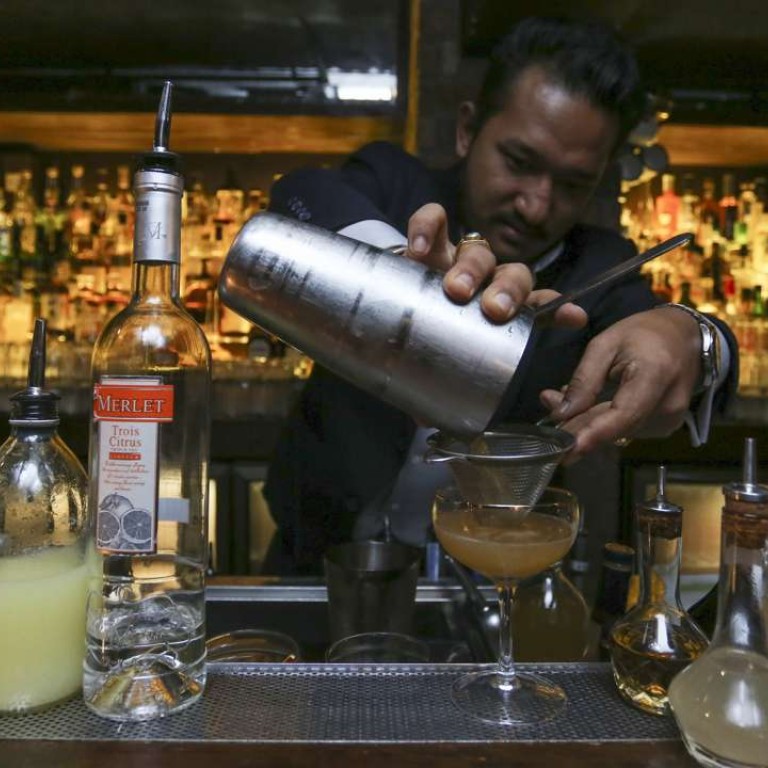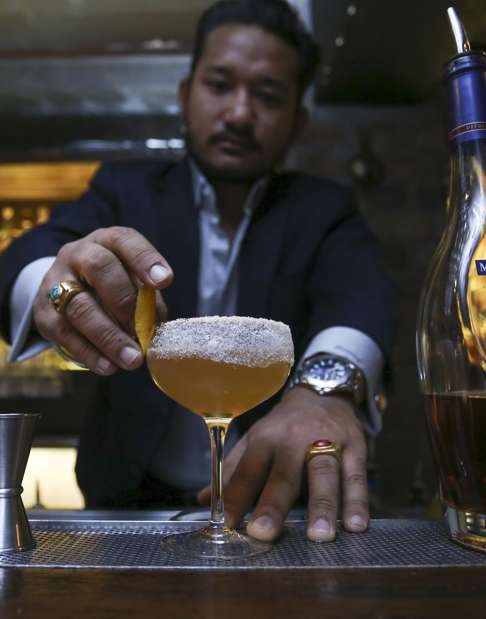
Sidecar’s a cocktail with a 100-year history, though who invented it isn’t clear
In either the French or English version, the cognac-based drink is on tap from a mobile bar at Stockton in Hong Kong
The Sidecar, now almost a century old, is one of the more improbably named of the classic cocktails.
It gets its name from the detachable passenger carriers that used to be attached to the sides of motorbikes.
Now the Martell cognac house has converted one of those wheeled sidecars into a mobile bar, dispensing the liquid type. It is currently set up in Stockton, in Hong Kong’s Central district, fuelled by a draught version of the time-honoured marriage of cognac, lemon juice, and Triple Sec.
The bike/bar has been equipped with a chiller and tap system, configured along the same lines as a standard electric beer pump.
That means, of course, that the cocktail is premixed, but you can also order one prepared at the bar, where manager Suraj Gurung will shake for you either the French or English version.
“The original French recipe would have been equal parts cognac, citrus and orange liqueur,” he explains, “but the English recipe calls for more booze with two parts cognac.”
As is the case with so many cocktails, the details of the Sidecar’s origin are disputed.
“There are a couple of different stories,” says Gurung.
“What we know, and bartenders like to think, is that the cocktail was first created at the end of the first world war in Paris. At that time people liked their drinks strong, and there was this American war veteran for whom a bartender at his favourite watering hole made a cocktail. He made it with cognac – originally with orange liqueur and a little bit of lemon. This drink was characterised as a ‘Daisy’, meaning a drink with citrus and a little bit of sweetness.
“The veteran liked it so much that he kept coming back and ordering this drink for a long period of time, and the bartender noticed that he would always arrive on a bike with a sidecar attached to it, so they called it a Sidecar.”

We do not know the name of the American for whom – or by some accounts by whom – the drink was first mixed, although some versions of the story accord him the rank of captain.
Neither do we know the identity of the bartender who made it for him, or who he taught it to. Over the years different bars and bartenders have laid claim to its invention.
Among the claimants in Paris at various times have been the Ritz Hotel – although it had no bar before 1921 – and the New York Bar, subsequently Harry’s New York Bar, which opened in 1911.
Different editions of that bar’s cocktail book, Harry’s ABC Of Mixing Cocktails, credit it to Pat McGarry of Buck’s Club in London, and later to New York Bar manager and eventual owner Harry MacElhone himself.
McGarry is generally credited with popularising the Sidecar in London, but if it was his invention then it probably wasn’t first mixed in Paris, which rather spoils the story of the shadowy captain and his motorcycle.
What we know, and bartenders like to think, is that the cocktail was first created at the end of the first world war in Paris
It certainly caught on in its stronger form in London in time for inclusion in the Savoy Cocktail Book in 1930 with a recipe calling for “1/4 lemon juice, ¼ Cointreau, and ½ brandy”.
There may also have been more complicated versions, and there is a school of thought that believes the Sidecar as we know it is a much simplified drink.
Gurung’s version also includes simple syrup, and he serves the cocktail in an old-fashioned champagne coupe glass, rimmed with sugar. He also twists a lemon peel garnish over the glass, to release the oils, and rubs the stem and the sides of the glass with it.
Those mixing it at home can experiment with all kinds of subtle variations including different types of orange liqueur – Grand Marnier is another favourite – or substituting armagnac or another brandy for cognac.
There is some advantage to the draught version at Stockton – Gurung points out that the ingredients have more time to marry before being dispensed, but you could also premix your own at home and refrigerate it overnight.
Whatever the truth of its origins, the Sidecar is a survivor. In one form or another almost a century after it was first mixed, its wheel still keeps on turning. Most good cocktail bars in town will be able to mix you one.
Four places to catch a Sidecar in Hong Kong
Stockton, 32 Wyndham Street, Central, tel: 2565 5268
The Bar, 1/F The Peninsula, 22 Salisbury Road, Tsim Sha Tsui, tel: 2696 6773
Butler, 5/F, Mody House, 30 Mody Road, Tsim Sha Tsui, tel: 2724 3828
MO Bar, Landmark Mandarin Oriental, 15 Queen’s Road Central, tel: 2132 0077

